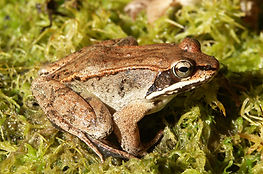Wood Frog
Lithobates sylvaticus
Adults
Eggs
Larvae
The adult wood frog, Lithobates sylvaticus, is a medium sized (1.5-2.5"), light tan to dark brown, terrestrial frog found in moist woodlands (1). It is easily recognized by the dark “mask” extending from each eye back through the tympanum. As the name implies, this frog is not an animal of ponds and streams but one which spends it life in the woodlands and vegetated wetlands of our region.
In early spring, shortly after thawing from their winter dormancy, wood frogs migrate to temporary wetlands for breeding. The males set up a raucous, quacking, breeding chorus. Mating and egg laying follow (2) and are completed within a few weeks, upon which adults leave the vernal pool to return to nearby uplands. The adults sometimes overwinter partially frozen under the leaf litter of the forest floor.
Listen for wood frog choruses at vernal pools in March and early April. Frogs will call at night and on warm days. Adults are secretive during daylight and seek cover when disturbed. At night, chorusing adults can usually be observed by flashlight. Other than the breeding season, look for wood frogs in woodlands and adjacent habitat. Encounters will be by chance since they are very difficult to see among the leaves of the forest floor, but may may be seen hopping away when disturbed.
An egg mass (3) is a gelatinous fist-sized blob consisting of up to 1,500 individual eggs. Individual eggs are .25-.5" spheres containing a black embryo. There is no outer gelatinous matrix surrounding the eggs. While in amplexus, females attach their eggs to vegetation in shallow water near or at the water surface. Egg masses are attached to tussock sedges and woody stems in sunny locations of a vernal pool, particularly in the northwest section. If the pool is dominated by emergent vegetation such as buttonbush, eggs are often found in clearings or other locations which receive maximum sunlight. Often, many females lay eggs in the same area in large communal clusters 4). Within a few days of deposition, growth is obvious and embryo development can be observed. Larvae hatch in about 28 days. Egg masses quickly become colonized by a symbiotic algae (Oophila amblystomatis) (5). Green egg masses floating at the water surface might easily be mistaken for clumps of algae.
Wood frog larvae are dark brown to blackish tadpoles. Immediately after hatching the tadpoles are black, about .25" long and found on or near the egg mass. They remain with the egg mass for a few days grazing on the symbiotic algae before swimming throughout the pool. As they grow, the dorsal color becomes brown and the venter develops gold flecking (6). The tail fin ends near the base of the tail.They feed on algae and leaf material on the pool bottom and grow rapidly so as to undergo metamorphosis before the pool dries. By June, these tadpoles will have developed legs and begun their emergence onto land.
Tadpoles are preyed upon by various aquatic insects (diving beetle adults & larvae, giant water bugs, etc.) as well as northern water snakes, ribbon snakes, turtles and various wading birds.Tadpoles hatch from egg masses in April. Spent egg masses appear as green blobs in the water but have the gelatinous feel and appearance of eggs. Tadpoles often school in shallow areas of the pool or float near the surface. Both activities provide solar heat to warm them in the relatively cool waters of a vernal pool. Running a net through the water is sure to capture some of these tadpoles if they are present, since they are usually in abundance (7). Toad eggs are laid a few weeks after wood frog eggs and toad tadpoles will be smaller than wood frog larvae when both are present (6).
By June, the tadpoles will have developed legs and be absorbing their tail (8) in preparation for leaving the pool. In years when the vernal pool dries before the development of the tadpole is complete, thousands of tadpoles flop about in the muck and become food for numerous birds, mammals, reptiles and insects as they dry and die.
Those frogs which complete development (9) leave the pool as a miniature version of the adult frog and venture into the uplands to spend their life searching for insects and other invertebrates to eat.
(For certification purposes, a recording of a wood frog chorus or photographs similar to #2-8 would be suitable evidence of wood frogs breeding in a vernal pool. See Certification for details.)
WOOD FROG CHORUS


1. Female wood frogs laden with eggs heading to a vernal pool.

2. Wood frogs in amplexus with a cluster of several egg masses.

3. A fist-sized wood frog egg mass, on the right, along with egg masses of spotted salamaner (upper) and Jefferson salamander (left).

4. Hundreds of wood frog egg masses attached to emergent vegetation in a vernal pool.

5. Developing wood frog eggs in a mass colonized by the alga Oophila amblystomatis.

6. Gold flecking becomes distinctive as the wood frog tadpole matures. The black tadpole is a recently hatched American frog larva.

7. Wood frog tadpoles appear to be black when viewed from a distance. They often school is warm shallow waters at the edge of a vernal pool.

8. Fully developed wood frog tadpole about to emerge as a wood frog.

9. Recently metamorphosed (emerged) tadpole which is now a terrestrial frog. It still has a bit of tail stub remaining.
The Wikipedia account for Wood Frog is recommended.

